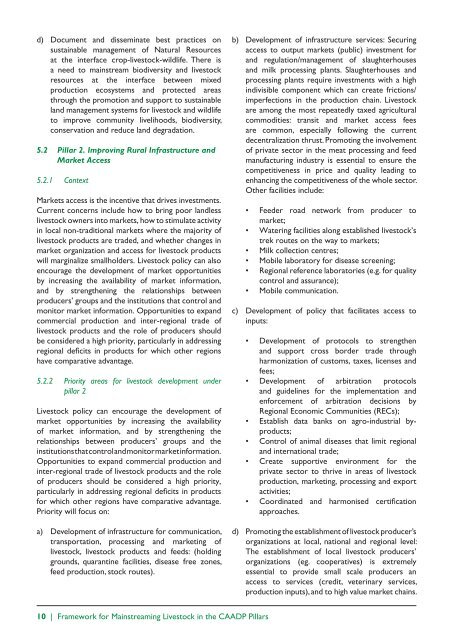Action Plan for the development of livestock - CAADP
Action Plan for the development of livestock - CAADP
Action Plan for the development of livestock - CAADP
You also want an ePaper? Increase the reach of your titles
YUMPU automatically turns print PDFs into web optimized ePapers that Google loves.
d)5.25.2.1Document and disseminate best practices onsustainable management <strong>of</strong> Natural Resourcesat <strong>the</strong> interface crop-<strong>livestock</strong>-wildlife. There isa need to mainstream biodiversity and <strong>livestock</strong>resources at <strong>the</strong> interface between mixedproduction ecosystems and protected areasthrough <strong>the</strong> promotion and support to sustainableland management systems <strong>for</strong> <strong>livestock</strong> and wildlifeto improve community livelihoods, biodiversity,conservation and reduce land degradation.Pillar 2. Improving Rural Infrastructure andMarket AccessContextMarkets access is <strong>the</strong> incentive that drives investments.Current concerns include how to bring poor landless<strong>livestock</strong> owners into markets, how to stimulate activityin local non-traditional markets where <strong>the</strong> majority <strong>of</strong><strong>livestock</strong> products are traded, and whe<strong>the</strong>r changes inmarket organization and access <strong>for</strong> <strong>livestock</strong> productswill marginalize smallholders. Livestock policy can alsoencourage <strong>the</strong> <strong>development</strong> <strong>of</strong> market opportunitiesby increasing <strong>the</strong> availability <strong>of</strong> market in<strong>for</strong>mation,and by streng<strong>the</strong>ning <strong>the</strong> relationships betweenproducers’ groups and <strong>the</strong> institutions that control andmonitor market in<strong>for</strong>mation. Opportunities to expandcommercial production and inter-regional trade <strong>of</strong><strong>livestock</strong> products and <strong>the</strong> role <strong>of</strong> producers shouldbe considered a high priority, particularly in addressingregional deficits in products <strong>for</strong> which o<strong>the</strong>r regionshave comparative advantage.5.2.2Priority areas <strong>for</strong> <strong>livestock</strong> <strong>development</strong> underpillar 2Livestock policy can encourage <strong>the</strong> <strong>development</strong> <strong>of</strong>market opportunities by increasing <strong>the</strong> availability<strong>of</strong> market in<strong>for</strong>mation, and by streng<strong>the</strong>ning <strong>the</strong>relationships between producers’ groups and <strong>the</strong>institutions that control and monitor market in<strong>for</strong>mation.Opportunities to expand commercial production andinter-regional trade <strong>of</strong> <strong>livestock</strong> products and <strong>the</strong> role<strong>of</strong> producers should be considered a high priority,particularly in addressing regional deficits in products<strong>for</strong> which o<strong>the</strong>r regions have comparative advantage.Priority will focus on:b)c)Development <strong>of</strong> infrastructure services: Securingaccess to output markets (public) investment <strong>for</strong>and regulation/management <strong>of</strong> slaughterhousesand milk processing plants. Slaughterhouses andprocessing plants require investments with a highindivisible component which can create frictions/imperfections in <strong>the</strong> production chain. Livestockare among <strong>the</strong> most repeatedly taxed agriculturalcommodities: transit and market access feesare common, especially following <strong>the</strong> currentdecentralization thrust. Promoting <strong>the</strong> involvement<strong>of</strong> private sector in <strong>the</strong> meat processing and feedmanufacturing industry is essential to ensure <strong>the</strong>competitiveness in price and quality leading toenhancing <strong>the</strong> competitiveness <strong>of</strong> <strong>the</strong> whole sector.O<strong>the</strong>r facilities include:• Feeder road network from producer tomarket;• Watering facilities along established <strong>livestock</strong>’strek routes on <strong>the</strong> way to markets;• Milk collection centres;• Mobile laboratory <strong>for</strong> disease screening;• Regional reference laboratories (e.g. <strong>for</strong> qualitycontrol and assurance);• Mobile communication.Development <strong>of</strong> policy that facilitates access toinputs:• Development <strong>of</strong> protocols to streng<strong>the</strong>nand support cross border trade throughharmonization <strong>of</strong> customs, taxes, licenses andfees;• Development <strong>of</strong> arbitration protocolsand guidelines <strong>for</strong> <strong>the</strong> implementation anden<strong>for</strong>cement <strong>of</strong> arbitration decisions byRegional Economic Communities (RECs);• Establish data banks on agro-industrial byproducts;• Control <strong>of</strong> animal diseases that limit regionaland international trade;• Create supportive environment <strong>for</strong> <strong>the</strong>private sector to thrive in areas <strong>of</strong> <strong>livestock</strong>production, marketing, processing and exportactivities;• Coordinated and harmonised certificationapproaches.a)Development <strong>of</strong> infrastructure <strong>for</strong> communication,transportation, processing and marketing <strong>of</strong><strong>livestock</strong>, <strong>livestock</strong> products and feeds: (holdinggrounds, quarantine facilities, disease free zones,feed production, stock routes).d)Promoting <strong>the</strong> establishment <strong>of</strong> <strong>livestock</strong> producer’sorganizations at local, national and regional level:The establishment <strong>of</strong> local <strong>livestock</strong> producers’organizations (eg. cooperatives) is extremelyessential to provide small scale producers anaccess to services (credit, veterinary services,production inputs), and to high value market chains.10 | Framework <strong>for</strong> Mainstreaming Livestock in <strong>the</strong> <strong>CAADP</strong> Pillars
















